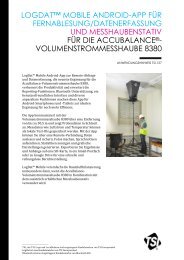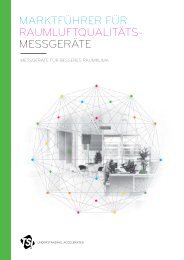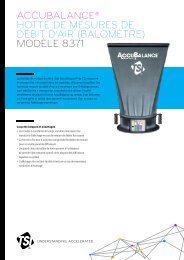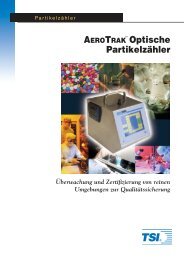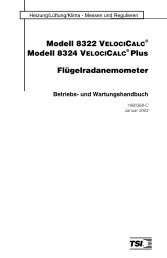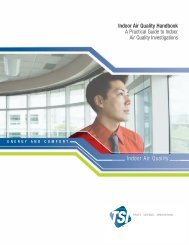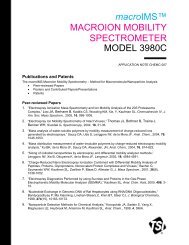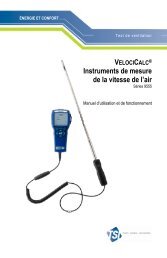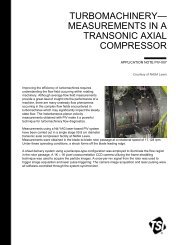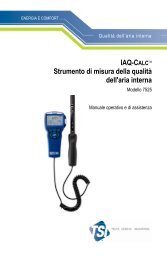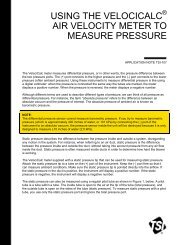Model 3340 Laser Aerosol Spectrometer Bibliography - Tsi
Model 3340 Laser Aerosol Spectrometer Bibliography - Tsi
Model 3340 Laser Aerosol Spectrometer Bibliography - Tsi
Create successful ePaper yourself
Turn your PDF publications into a flip-book with our unique Google optimized e-Paper software.
Willeke, PhD Klaus; Qian, PhDYinge. “Tuberculosis Control Through Respirator Wear: Performance of<br />
National Institute for Occupational Safety and Health-Regulated Respirators (supported in part by the<br />
National Institute for Occupational Safety and Health through grant number R01-OH-03244. Yinge Qian,<br />
PhD, also was partially supported for 1 year by a graduate scholarship from the University of<br />
Cincinnati.),” American Journal of Infection Control, 26:2, (April 1998) 139–142.<br />
Department of Environmental Health, University of Cincinnati, Ohio USA.<br />
Abstract:<br />
Background: In 1995 the National Institute for Occupational Safety and Health issued new rules for<br />
personal respirators. All nine new respirator categories are authorized in health care facilities for the<br />
prevention of the transmission of tuberculosis (TB) The new N95 respirator category is the most<br />
frequently used for this purpose. Data are presented on their efficiency for collecting TB-size bacteria<br />
and their potential for re-aerosolizing collected bacteria.<br />
Methods: All measurements of bacterial penetration were performed with dynamic aerosol size<br />
spectrometers at flow conditions corresponding to normal wear and respirator certification conditions.<br />
The re-aerosolization tests were performed at conditions ranging from normal breathing to violent<br />
coughing or sneezing.<br />
Results: The tested N95 respirators collected 0.1 to 0.3 μm particles with efficiencies of 95% or<br />
higher, as specified by the regulations. TB-size bacteria of 0.8 μm and larger, however, were collected<br />
with 99.5% or higher efficiencies; that is, the penetration of these bacteria through the filter material<br />
was 0.5% or less, much less than the required maximum penetration of 5% for the smaller particle<br />
sizes. No bacteria were re-aerosolized during normal exhalation. Some re-aerosolization (0.1% or<br />
less) was observed only at low humidity and extremely high air flow through the respirator,<br />
corresponding to violent coughing or sneezing.<br />
Conclusions: The filter materials of N95 respirators provide good protection against TB bacteria.<br />
Thus, a significant number of bacteria can enter the respirator-wearer's breathing space only through<br />
spaces where the respirator inadequately seals to the wearer's face. Re-entrainment and reaerosolization<br />
of mycobacteria is not a problem when normal work practices are observed in health<br />
care facilities.<br />
1997<br />
Chang, Y.-C.; Lin, J.-C.; Gentry, J.W, “Charge Distribution Estimation for Non-spherical Particles,”<br />
Journal of <strong>Aerosol</strong> Science, 28:1001, (1997) S653–S654.<br />
Cheng, S.-H.; Ranade, M.B.; Gentry, J.W. “Experimental Design of High Volume Electrostatic Charger,”<br />
<strong>Aerosol</strong> Science and Technology, 26 (5), (May 1997) 433–446.<br />
Abstract: A corona charger was developed for charging aerosols having flow rates of 0.6 to 6.0 m 3 /s.<br />
To prevent wall loss transpiration flow from 0.6 to 4.8 m 3 /s was introduced at 90° from the principal<br />
direction of flow. The redesigned charging section could produce ion currents as high as 10 -4 A for<br />
applied corona voltages below 10 kV. Calibration experiments with glass aerosols showed that<br />
particle penetration through the charging section could be substantially increased by the use of<br />
transpiration air, that the transpiration air did not alter the shape of the particle size distribution, and<br />
that for particles less than 0.5 μm, diffusion charging was the dominant mechanism.<br />
Grinshpun, S.A.; Willeke, K.; Ulevicius, V.; Juozaitis, A.; Terzieva, S.; Donnelly, J.; Stelma, G.N.;<br />
Brenner, K.P. “Effect of Impaction, Bounce and Re-aerosolization on the Collection Efficiency of<br />
Impingers,” <strong>Aerosol</strong> Science and Technology, 26 (4), (April 1997) 326–342.<br />
The collection efficiency of liquid impingers was studied experimentally as a function of the<br />
sampling flow rate with test particles in the bacterial size range. Three impingers were tested: two<br />
All-Glass Impingers (AGI-4 and AGI-30), widely used for bioaerosol sampling, and a newly<br />
-22-



